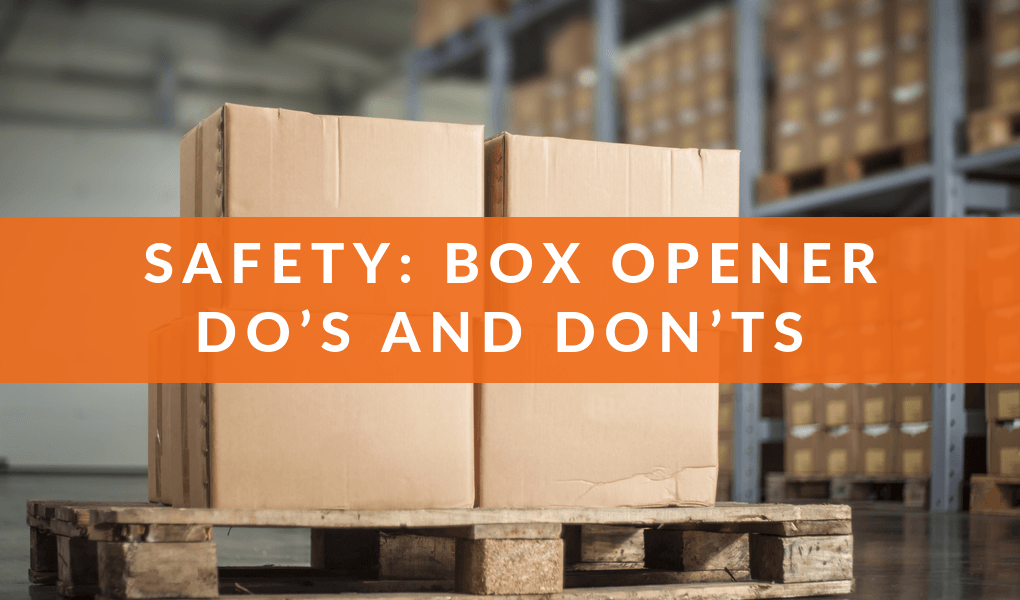Safety: Box Opener Do’s and Don’ts

Safer box opening practices start with the selection of a safety box opener and carry on through the use and storage of this handy tool. As with any bladed tool, a too-sharp edge presents greater inherent risk.
Selecting a Safety Box Opener
Slice® makes an entire line of safer box cutters that provide your workers with a choice of handles to suit their preferences. How do you choose the best one? Start by considering these factors:
- Is the tool safe?
- Is the tool durable?
- Is the tool ergonomic?
- Is the tool easy to carry and store?
- Is the blade easy to change?
At Slice, all of our tools are designed and manufactured with safety in mind. Traditional box openers, with their overly sharpened blades, are extremely dangerous. Our finger-friendly® blades are only as sharp as they need to be to get the job done.
Blades on metal box cutters dull very quickly, necessitating frequent blade replacement. The more frequently your workers handle a traditional blade, the more they expose themselves to the risk of a laceration. Our specially ground ceramic blades last up to 11 times longer than metal blades. So during blade replacement, as during use, our blades are safe to the touch.
Most of our box openers have ergonomic handle designs, making them safer and more comfortable to use. A tool that operates like an extension of a worker’s hand and arm prevents awkward grip angles and movements, reducing the muscle fatigue that leads to repetitive strain injuries.
The innovative ergonomic J-hook handle design of our 10400 Manual Box Cutter and its companion, the 10503 Auto-Retractable Box Cutter, holds your wrist at a healthy angle while the bottom of the curved handle rests between your hand and the box, keeping fingers safe from staples.
Check out this video to see the auto-retractable model of this innovative box opener in action:
====
These box cutters, Slice’s original model, are shipped with our 10404 Box Cutter Blades (Rounded-Tip) as a safety measure (rounded tips cut down on puncture risk). This blade will handle most single- or double-walled corrugated cutting tasks. These handles are also compatible with our 10408 Box Cutter Blades (Pointed-Tip).
Safety Practices for Box Openers
As part of your new employee orientation and routine safety talks, make sure that you frequently cover the topic of box cutter safety. If you don’t use auto-retractable models, remind your workers to retract blades when the tool is not being used. Stress routine inspection of their box cutters for damage. Reinforce the idea that a box cutter is designed for cutting boxes. It shouldn’t be used as a substitute for any other tool.
Enforce the use of Personal Protective Equipment (PPE), such as protective gloves. Teach your workers how to keep their bodies away from the cutting line—if the knife slips and continues beyond the box’s surface, will it contact their body? If yes, it’s time to use a different body position. Provide workers with stable cutting surfaces, and remind them to keep their minds focused on the job at hand.
Any bladed tool can be dangerous if your workers aren’t mindful of the blade when they carry it, use it, store it, or replace its blade. Don’t let your workers fall into sloppy box cutter habits.
For safety reasons, we recommend auto-retractable tools. The instant retraction of the blade into the housing when the slider is released means one less safety practice your workers have to remember. Don’t tolerate the taping open of the slider mechanism on an auto-retractable box cutter to keep the blade exposed. This workaround is dangerous.
Many of our box openers are small enough that your workers can carry them in shirt, pants, or lab coat pockets. Most have lanyard holes so workers can wear them, keeping them handy. Some even have magnets in their handles for easy attachment to a shelf or toolbox. Keeping our safer tools handy fosters compliance among workers.
With a traditional blade, carrying a box opener in a pocket or tossing it into a toolbox is an invitation to an injury. When your worker reaches into a pocket or rummages around in their toolbox, their hand is likely to encounter the dangerously sharp blade, with painful and costly results. Even if a Slice safety blade is left exposed, it’s highly unlikely to result in a laceration from incidental contact.
Eventually, even our longer-lasting safety blades will need a replacement. Using our J-hook handle box cutters as an example, watch this video to see how safely, quickly, and easily Slice blades are replaced.
====


0 Comments on "Safety: Box Opener Do’s and Don’ts"